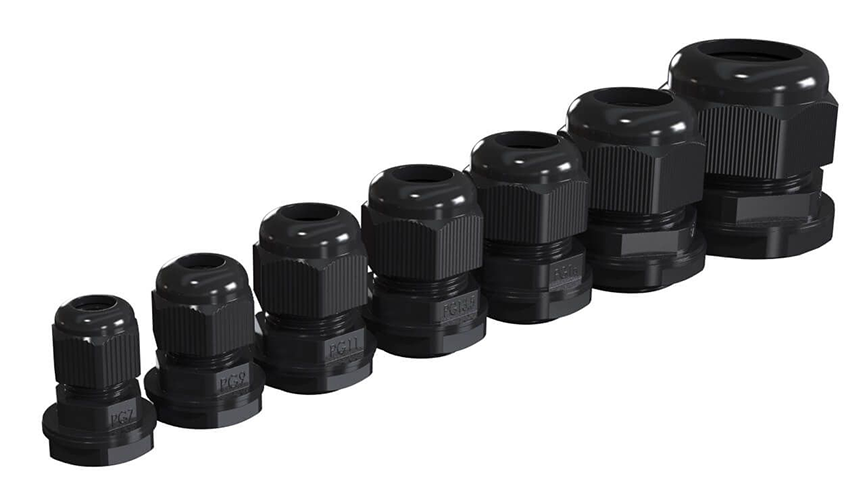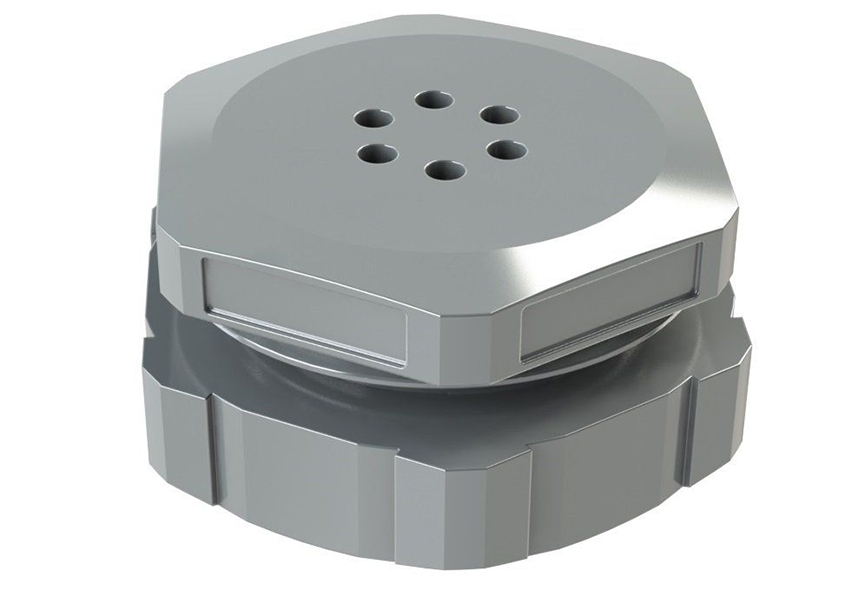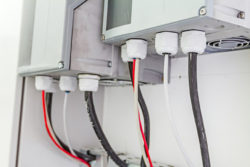- URL
Share
Cable glands and enclosure vents are some of the most important components of an electronics enclosure. They help to protect crucial enclosure features, such as cable entries, and maintain the enclosure’s waterproof performance.
In this TechTalk blog, we’ll take a look at the different types of cable glands, enclosure vent plugs and other cable and venting accessories Polycase offers. First, let’s examine why your enclosures might need cable glands or vent seals in the first place.

Source: Roman023_photography/Shutterstock.com
Basics of Cable Glands and Enclosure Vent Plugs
Many electrical and electronics devices require cables to connect them with electrical grids, automation systems, communications networks and other crucial infrastructure elements. However, this typically requires cutouts in the electronics enclosure to allow the cables to enter and exit, and that can compromise the ability of a waterproof electrical box to provide NEMA rated or IP rated protection against liquids and solids.
Use a Waterproof Electrical Box to Keep Everything Inside Safe from Getting Wet
Vented enclosures often face a similar problem. Many enclosures require venting to prevent unsafe temperature rise inside the enclosure and keep the device at a safe operating temperature. However, adding vents to an enclosure can make it substantially more difficult to prevent dust and moisture from entering the enclosure.
That’s why cable glands and enclosure vent plugs are so important. Here’s how these two components work:
- Cable glands are small rounded nylon pieces with a hole in the center. They’re designed to be slipped over a cable and fitted to the cable’s entry point into the enclosure to provide a watertight and dust tight seal.
- Enclosure vent plugs are circular nylon plugs with a single-direction filter or membrane. These can be fitted over ventilation openings to create a waterproof air vent that allows the enclosure to be vented but prevents moisture from entering.
You’ll find these components used in a wide variety of applications—from manufacturing facilities to marine environments. Most are compatible with a variety of enclosure models—from a standard clear waterproof box to a diecast aluminum enclosure.

Polycase CG1 Cable Gland Series
Polycase NEMA 4X Cable Glands
Our CG1 series cable gland models are rated for NEMA 4X/IP66 performance. They’re molded from sturdy black nylon and can tolerate temperatures from -40ºF to 212ºF. Each model is built to accommodate a different cable diameter size, ranging from 0.118 up through 0.945 inches.
Need the Insides to Be Visible? Use a Clear Waterproof Box Instead
Polycase NEMA 6P Cable Glands
When you need cable glands for the most demanding conditions, our CG3 cable gland models are rated for NEMA 6P/IP68 performance, which includes protection against prolonged submersion in water. Each model is made from thick gray nylon, tolerates temperatures of -40°F to 239°F and accommodates cable diameters from 0.115 through 1.26 inches. These models’ locking nut and ratchet design eliminates the need for an O-ring and provides extra protection against vibrations.
Polycase Stepped Cable Seals
Our stepped cable seals are designed to provide a versatile cable gland seal solution for cable entry points. These highly cost-effective and versatile plastic seals can be cut to the size of your choice and provide an IP55 rated seal.
Polycase Cable Enclosure Vent Plugs
The easiest and most effective way to provide ventilation for your enclosure without exposing it to moisture accumulation is to use a one-way cable enclosure vent plug or cable enclosure vent seal. These threaded vent plugs are designed for one-way air flow that allows moisture and heat to exit the enclosure but prevents moisture from coming back in. They provide various levels of NEMA and IP-rated protection for superior water ingress protection in your enclosure.
More Resources on Cable Glands and Enclosure Cables
For a further introduction to our line of cable glands and enclosure vents, see this video:
Additionally, when choosing cabling solutions for your enclosure, make sure to consider relevant factors, such as OSHA cabling design standards, and read the latest research on topics, such as the electromagnetic susceptibility of a folded cable of finite thickness in a shielded enclosure to external excitation.

Polycase UA-006 Vent Plug
Finally, if you need more guidance, feel free to contact our enclosure experts at 1-800-248-1233 or contact us online. We’ll be happy to help you outfit your electronics enclosure with the accessories that will keep your device safe and well-protected.
0 Comment
